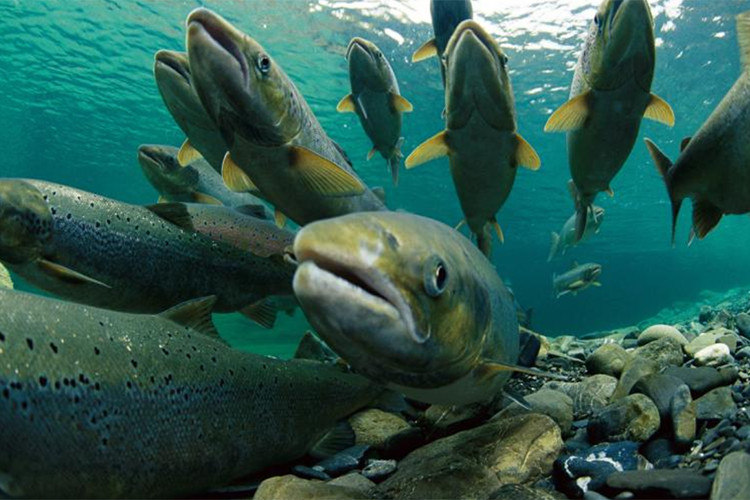Bycatch
Salmon are caught incidentally as bycatch in commercial fisheries that target other species. This unintended catch can impact salmon fisheries and non-salmon fisheries. A lot of bycatch can affect salmon populations and lead to early fishery closures. Working with the fishing industry and other partners, we work to monitor and estimate bycatch accurately. We also research and develop tools to reduce incidental catch of salmon. We developed bycatch reduction devices for the Pacific whiting industry aimed at reducing Chinook salmon bycatch.
Climate Change
Salmon are cold-water species. Predicted increases in water temperature and decreases in summer river flows under climate change are likely to affect their ability to survive. We help estimate the effects of ocean climate changes, streamflow, and temperature on habitat and salmon populations. We also help evaluate the efficacy of habitat restoration actions in the face of climate change.
Ecosystem
We track changes in the environment and their impact on fish populations and communities that depend on them. Salmon are anadromous, meaning they spend some of their lives in both freshwater and saltwater. Pacific salmon are born in freshwater, spend most of their lives in saltwater, and return to the same freshwater rivers to spawn. Our research findings contribute to the California Current Integrated Ecosystem Status report, which summarizes and synthesizes historical and possible future effects of climate and fishing on large marine ecosystems. Our scientists also use economic information to help policymakers better weigh the tradeoffs involved in salmon recovery planning decisions. Learn more about our work on the human dimensions of Pacific salmon recovery.
Ecotoxicology and Environmental Chemistry
Pesticides and other chemical contaminants can get into the aquatic environment and can accumulate through the food chain. They can affect salmon and other aquatic plants and animals. We monitor levels of these toxic chemicals in salmon and study their effects on salmon and their habitat.
Forecasting Salmon Returns
Since 1996, the Center has monitored the ocean environment off the Washington and Oregon coasts, its interaction with the California Current, and how ocean conditions affect salmon. This ongoing research helps us better understand some critical relationships between climate, oceanography, and biology that largely determine the fate of salmon entering the ocean during specific years. We use a suite of ocean indicators to predict adult Chinook and coho salmon returns up to 2 years in advance.
Genetics
We use advanced genetic tools to characterize salmon diversity, identify the origins of mixed salmon stocks caught in U.S. commercial fisheries, measure salmon fitness in the wild, and evaluate the effects of hatchery domestication, fishing, and climate change. We are also developing methods to use DNA in the environment (eDNA) as a tool for monitoring salmon distribution and abundance. Learn more about our studies on the genetics and evolution of salmon.
Growth and Survival of Juvenile Salmon
Our scientists study the growth and ocean ecology of juvenile salmon in the Columbia River estuary and Northern California Current. We also study their migrations from the rivers to the ocean.
Habitat
After decades of urban development, agricultural, forestry, and energy development impacts, restoring freshwater habitats is a critical component of all salmon recovery plans in the Pacific Northwest. We assess the effects of ongoing restoration activities, evaluate the impact of removing passage barriers such as the Elwha River dams, examine the potential for habitat improvement across landscapes such as the Columbia River Basin.
Hatcheries
Studies of wild salmon have improved hatchery rearing and integration of natural and hatchery production. Conversely, physiological studies on hatchery salmon have helped define habitat-related threats to wild fish. Captive rearing of salmon stocks listed under the Endangered Species Act includes Idaho’s Redfish Lake sockeye salmon and Chinook salmon stocks of Oregon and Washington. The Hatchery Scientific Reform Group and other organizations in the Pacific Northwest develop hatchery reform guidelines.
Marine Survival
A salmon’s first year at sea is the most critical for its survival to adulthood. We observe changes in salmon survival, age structure, and size to establish long-term patterns of marine survival. We use innovative technologies such as acoustic telemetry (using sound-emitting tags to track fish) and autonomous underwater robots to determine where salmon go when they enter the marine environment.



